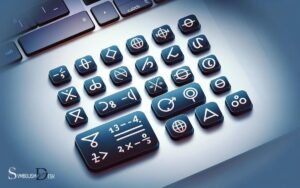What Does the Union Symbol Mean in Math? More Sets!
In mathematics, the union symbol (∪) represents the operation of joining all the distinct elements from two or more sets.
When sets A and B are combined using the union operation, the resulting set includes every element that is either in A, in B, or in both, without any duplicates.
The union of sets is a fundamental concept within set theory, which is a branch of mathematical logic. It allows for the creation of a new set that encompasses all elements from the included sets.
Here’s a simple example to illustrate the union operation:
Understanding the union symbol is crucial for comprehending complex set operations and their applications in mathematics.

Key Takeaway
Origins of the Union Symbol
The union symbol in mathematics, denoted by the symbol ∪, has its origins in set theory and was first introduced by the mathematician Georg Cantor in the late 19th century.
In set theory, the union of sets A and B, denoted by A ∪ B, represents the set of elements that are in A, in B, or in both A and B.
This concept is fundamental in understanding the relationships between different sets and is extensively used in various mathematical disciplines, including calculus, probability, and statistics.
The union symbol allows mathematicians and scientists to succinctly express the combination or amalgamation of sets, making it a powerful tool for representing complex relationships and operations within the realm of mathematics.
Georg Cantor’s introduction of the union symbol marked a significant advancement in the formalization and notation of set theory, paving the way for its widespread use in modern mathematics.
Definition and Usage in Set Theory
Having its roots in set theory, the union symbol, denoted by ∪, is used to represent the combination of sets and plays a fundamental role in illustrating the relationships between different sets in mathematics.
- Combining Sets: The union of sets A and B, denoted as A ∪ B, consists of all elements that are in A, in B, or in both.
- Set Theory: In set theory, the union is one of the fundamental operations alongside intersection, complement, and difference.
- Mathematical Notation: The symbol ∪ is used to succinctly express the union operation, simplifying mathematical expressions and representations.
- Venn Diagrams: The union of sets can be visually represented using Venn diagrams, providing a clear visualization of the combined elements from the sets.
Properties and Operations of Union
Originating from set theory and playing a fundamental role in illustrating the relationships between different sets in mathematics, the properties and operations of the union symbol provide essential insights into the combination of sets.
The union of two sets A and B, denoted as A ∪ B, comprises all elements that are in A, in B, or in both.
The properties and operations of the union symbol can be summarized as follows:
| Property | Operation | Example |
|---|---|---|
| Associativity | A ∪ (B ∪ C) = (A ∪ B) ∪ C | {1, 2} ∪ ({2, 3} ∪ {4}) = ({1, 2} ∪ {2, 3}) ∪ {4} |
| Commutativity | A ∪ B = B ∪ A | {1, 2} ∪ {3, 4} = {3, 4} ∪ {1, 2} |
| Identity | A ∪ ∅ = A | {1, 2} ∪ ∅ = {1, 2} |
Understanding these properties is crucial for various mathematical applications and problem-solving scenarios.
Venn Diagram Representation of Union
Representation of Union in Venn diagrams elucidates the combined elements of sets A and B. The Venn diagram for the union of sets A and B consists of two overlapping circles, with each circle representing a set.
The elements that are common to both sets A and B are placed in the overlapping section of the circles.
Here are the key aspects of the Venn diagram representation of union:
- Overlap: The overlapping area represents the elements that are present in both sets A and B.
- Entire Circles: The entire circles represent all the elements in sets A and B, including those that are not common to both sets.
- Clarity: Venn diagrams provide a visual representation that makes it easy to understand the concept of union.
- Set Notation: The union of sets A and B can be expressed as A ∪ B, where the symbol “∪” denotes the union operation.
Real-World Applications of the Union Symbol
The union symbol in mathematics, denoted as ‘∪’, is commonly used to represent the combined elements of two or more sets in real-world applications.
Real-world scenarios often involve the combination of different sets, and the union symbol is instrumental in representing such situations.
Below is a table illustrating real-world examples of the union symbol in action:
| Real-World Scenario | Representation using Union Symbol |
|---|---|
| Students participating in sports | A ∪ B |
| Available colors for a product | X ∪ Y ∪ Z |
| Membership of two clubs | M ∪ N |
| Types of fruits in a fruit salad | P ∪ Q ∪ R |
| Employees with certain skills | S ∪ T ∪ U |
In each scenario, the union symbol succinctly captures the combination of elements from different sets, demonstrating its practical significance in various real-world contexts.
Conclusion
The union symbol in math, originating from set theory, represents the combination of elements from two or more sets.
Its properties and operations make it a fundamental concept in mathematics, often depicted through Venn diagrams to illustrate the relationship between sets.
The union symbol is widely used in various real-world applications, demonstrating its significance in both theoretical and practical contexts.






